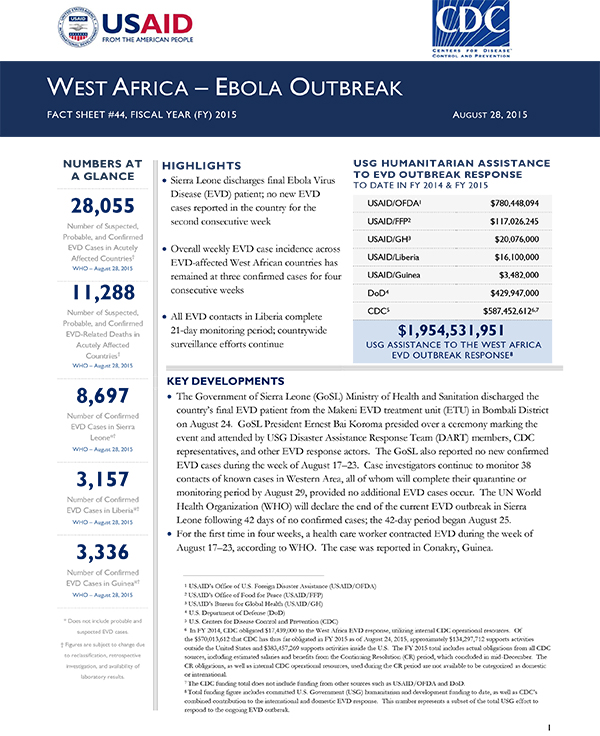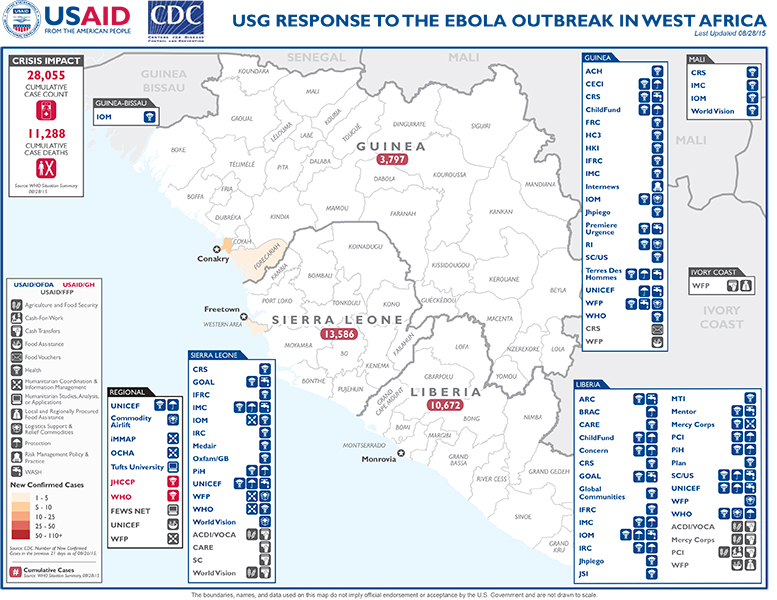Speeches Shim
August 28, 2015
HIGHLIGHTS
Ebola Response
Visit our main West Africa Ebola Outbreak page to learn more about how we're responding to the West Africa Ebola outbreak, and what you can do to help.
- Sierra Leone discharges final Ebola Virus Disease (EVD) patient; no new EVD cases reported in the country for the second consecutive week
- Overall weekly EVD case incidence across EVD-affected West African countries has remained at three confirmed cases for four consecutive weeks
- All EVD contacts in Liberia complete 21-day monitoring period; countrywide surveillance efforts continue
KEY DEVELOPMENTS
West Africa Fact Sheet #44 - 08-28-2015 ![]() (pdf - 369k)
(pdf - 369k)
- The Government of Sierra Leone (GoSL) Ministry of Health and Sanitation discharged the country’s final EVD patient from the Makeni EVD treatment unit (ETU) in Bombali District on August 24. GoSL President Ernest Bai Koroma presided over a ceremony marking the event and attended by USG Disaster Assistance Response Team (DART) members, CDC representatives, and other EVD response actors. The GoSL also reported no new confirmed EVD cases during the week of August 17–23. Case investigators continue to monitor 38 contacts of known cases in Western Area, all of whom will complete their quarantine or monitoring period by August 29, provided no additional EVD cases occur. The UN World Health Organization (WHO) will declare the end of the current EVD outbreak in Sierra Leone following 42 days of no confirmed cases; the 42-day period began August 25.
- For the first time in four weeks, a health care worker contracted EVD during the week of August 17–23, according to WHO. The case was reported in Conakry, Guinea.
REGIONAL
During the week of August 17–23, WHO reported three new confirmed EVD cases in EVD-affected West African countries, marking the fourth consecutive week in which case incidence has remained at three. WHO also reports that the number of contacts under observation continues to fall, from more than 800 on August 16 to approximately 600 on August 23, with contacts in four prefectures of Guinea and two districts in Sierra Leone.
West Africa Map - 08-28-2015 ![]() (pdf - 594k)
(pdf - 594k)
Liberia
WHO reported no new EVD cases in Liberia during the week of August 17–23, with all contacts in Liberia having completed their 21-day follow-up period. Although Liberia discharged its final two EVD cases on July 23, the Government of Liberia (GoL) and other response actors continue to increase surveillance efforts, with WHO reporting that approximately 800 samples were tested for EVD from August 17 through 23—compared to an average of approximately 560 samples tested per week from mid-May to early August.
The UN Office for the Coordination of Humantiarian Affairs (OCHA) reports that a fourth EVD survivor clinic opened at the Redemption Hospital in Liberia’s capital city of Monrovia. The clinic provides treatment, support, and training for EVD survivors, and facilitates data collection to improve knowledge of post-EVD outcomes.
On August 13, DART members visited Monrovia’s Samuel K. Doe (SKD) Stadium, where USAID partner the UN World Food Program (WFP) manages the supply and distribution of EVD-related commodities. DART members assessed a recent shipment of USAID/OFDA-supplied personal protective equipment (PPE), as well as the planned transition of EVD-related assets from WFP to the GoL General Services Administration. Six containers of USAID/OFDA-procured PPE—including boots, coveralls, and gloves—arrived at the site on August 10 via the DoD Logistics Agency. WFP staff expect to receive additional containers of USAID/OFDA-donated PPE in the coming days. Together with staff from the GoL Ministry of Health (MoH) and WHO, WFP continues to pre-position PPE supplies at health care facilities throughout Liberia. The MoH and WHO request items for onward deployment to health care facilities, and the SKD team packages and prepares the goods for transport.
USAID/OFDA is supporting the International Organization for Migration (IOM) to work with County Health Teams and the GoL MoH Disease Prevention and Control Division to provide key resources, training, and mentoring support to major ports of entry and border communities in Bong, Grand Cape Mount, Grand Gedeh, Lofa, Maryland, Nimba, and River Gee counties. The USAID/OFDA-supported IOM project will complement existing activities performed under the Border Coordination Working Group framework, which aims to prevent the cross-border transmission of EVD.
Sierra Leone
WHO reports that the number of contacts under observation in Sierra Leone has declined from 72 across three districts—Tonkolili, Western Area Urban, and Western Area Rural—on August 19, to 29 contacts in Western Area Urban and Western Area Rural as of August 23. All remaining contacts will complete their quarantine or monitoring period on August 29, according to WHO.
Laboratory indicators continue to reflect a heightened degree of vigilance in Sierra Leone, with 1,805 samples tested between August 17 and 23. The majority of tests—approximately 78 percent—conducted during the one-week period were post-mortem swabs taken to rule out EVD as the cause of death.
On August 18, IOM and World Hope International (WHI), with support from USAID/OFDA, convened a conference of approximately 150 participants, including members of the USG DART, to examine the key role of cultural burial liaisons (CBLs) in reducing unsafe burials in Bombali. Between March and April 2015, IOM and implementing partner WHI recruited and trained 130 people in Bombali to serve as liaisons between GoSL-sanctioned burial teams and friends and family of the deceased. The project aimed to reduce the number of secret, unsafe burials by reducing community distrust and suspicion of burial team procedures. CBLs encouraged all community deaths to be reported to the District Ebola Response Center (DERC); reassured friends and family that the deceased would be treated in a dignified manner; and assisted burial teams to conduct culturally sensitive and safe burials. The Bombali DERC Social Mobilization Pillar reported that CBLs mitigated community reticence through awareness and outreach campaigns, while de-stigmatizing traditional burial practices by helping burial teams accommodate the ritual-related requests of friends and family members. Between April and mid-August, CBLs participated in 460 burials, approximately 22 percent of all burials, in Bombali.
Guinea
On August 21, approximately 352 contacts residing in Forécariah Prefecture’s Allasoya sub-prefecture completed the standard 21-day follow-up period for monitoring EVD symptoms. The Allasoya contacts were epidemiologically linked to a suspected case that had evaded contact tracers in Conakry, traveling through Forécariah and into neighboring areas of Sierra Leone. Health actors were monitoring approximately 600 remaining contacts in Guinea as of August 23, with an estimated 220 contacts registered in Forécariah, as well as 203 registerd in Ratoma and 122 registered in Matam, subprefectures of Conakry Prefecture.
USAID/OFDA recently provided more than $1.8 million to Catholic Relief Services (CRS) in Guinea to train health facility staff in infection prevention and control (IPC) and triage protocols, while strengthening sustainable quality-control systems. CRS will also provide materials—including gloves, safety boxes, and hand washing kits—to improve hygiene and adherence to IPC practices, as well as materials and services for the safe management of medical and other waste. With USAID/OFDA support, CRS will also rehabilitate hand pumps and latrines, increase the water storage capacity of targeted health faciltiies, and reinforce urban and rural hygiene committees.
In addition, USAID/OFDA supported Premiere Urgence with nearly $1.3 million to strengthen health systems and IPC in Dubréka and Coyah Districts. Premiere Urgence aims to set up triage areas and isolation rooms at health facilities to identify and separate potential EVD cases quickly. Premiere Urgence will also distribute IPC materials, including boots, buckets, chlorine soap, and hand washing supplies to the targeted health facilities.
PUBLIC DONATION INFORMATION
- The most effective way people can assist relief efforts is by making cash contributions to humanitarian organizations that are conducting relief operations. A list of humanitarian organizations that are accepting cash donations for disaster responses around the world can be found at www.interaction.org.
- USAID encourages cash donations because they allow aid professionals to procure the exact items needed (often in the affected region); reduce the burden on scarce resources (such as transportation routes, staff time, and warehouse space); can be transferred very quickly and without transportation costs; support the economy of the disaster-stricken region; and ensure culturally, dietary, and environmentally appropriate assistance.
More information can be found at:
- The Center for International Disaster Information: www.cidi.org or +1.202.821.1999.
- Information on relief activities of the humanitarian community can be found at www.reliefweb.int.
USAID/OFDA bulletins appear on the USAID website at what-we-



Comment
Make a general inquiry or suggest an improvement.